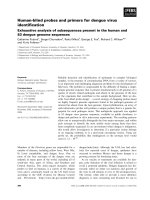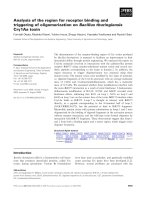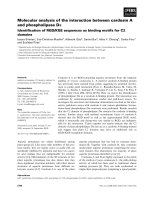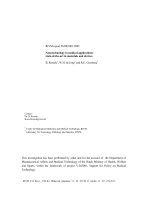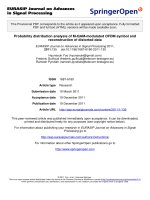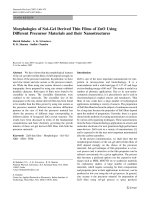Analysis of finite sized electromagnetic bandgap materials and devices by scattering matrix method
Bạn đang xem bản rút gọn của tài liệu. Xem và tải ngay bản đầy đủ của tài liệu tại đây (1.85 MB, 131 trang )
ANALYSIS OF F INITE- SIZED ELECTROMAGNETIC
B ANDGAP M ATERIALS AND D EVICES BY SCATTERING
M ATRIX M ETHOD
BY
WANG QUANXIN
B.ENG. BIOMEDICAL ENGINEERING
SHANGHAI JIAOTONG UNIVERSITY,
2001
A THESIS SUBMITTED
FOR THE DEGREE OF MASTER OF ENGINEERING
DEPARTMENT OF ELECTRICAL AND COMPUTER ENGINEERING
NATINAL UNIVERSITY OF SINGAPORE
2004
@ National University of Singapore, All Right Reserved 2004
i
ACKNOWLEDGEMENT
I would like to express my sincere gratitude to Dr. Zhang Yaojiang, not only for the clear
and valuable guidance and support to this project, which has led me get into the gate of
research, but also for the encouragement and positive comments, which have always
given me confidence in the last two years.
I am very grateful to Dr. Li Er Ping, who gives the expert advice, which has helped me a
lot in completing the project successfully. His guidance and comments have aided me in
solving difficulties and creating new ideas.
I must also thank Prof. Ooi Ban Leong, for helping me a lot in understanding basic
knowledge of Electromagnetics.
Acknowledgements should also go to other IHPC faculties, students and all my friends.
All of them created a happy and inspiring environment for me and greatly helped me
when I was doing my project.
I must take this opportunity to express my deep love and gratefulness to my parents. They
are always my source of encouragement.
Author
10 December 2003
i
ABSTRACT
Keywords: Electromagnetic bandgap (EBG), photonic crystals, scattering matrix method,
addition theorem, ferrite or chiral cylinder, tunable EBG devices
Besides conventional applications in frequency selective surfaces or gratings, periodic
structures regain extensive studies nowadays due to potential utilizations in either novel
patch antenna design or photonic crystal waveguides. The property of electromagnetic
bandgap (EBG), shown in photonic crystals, makes it very promising in future high
density optical interconnects.
In this thesis, scattering matrix method is used to simulate the transmission properties of
the finite-sized two dimensional EBG materials. By the implementation of addition
theorem, multiple scatterings for different dielectric rods are accurately modeled and the
forbidden frequency or wavelength bands are efficiently predicted. The results are
validated by comparison with other methods as well as some reference data.
The method is extended to study some novel EBG structures which contain ferrite or
chiral cylinders as defects, where several tunable pho tonic crystal devices are proposed
including ferrite defect filters, couplers and Y-branches. The study provid es a new
approach to control the flow of light in photonic crystals.
ii
Analysis of Finite-sized EBG Materials and Devices by Scattering Matrix Method
Table of Contents
3
TABLE OF CONTENTS
ABSTRACT… … … … … … … … … … … … … … … … … … … … … … … … … … … . . … … . I
ACKNOWLEDGEMENT … … … … … … … … … … … … . .… … … … … … … … … … … II
SUMMARY … … … … … … … … … … … … . .… … … … … … … … … … … … … … … … ...III
1 INTRODUCTION....................................................................................................... 1
2
3
1.1
PROBLEM D ESCRIPTION ....................................................................................... 1
1.2
SCOPE OF WORK .................................................................................................. 2
1.3
O RIGINAL C ONTRIBUTION .................................................................................... 3
BACKGROUND KNOWLEDGE ........................................................................... 4
2.1
E LECTROMAGNETIC BANDGAP STRUCTURE......................................................... 4
2.2
SCATTERING MATRIX METHOD.......................................................................... 7
T-MATRIX OF CONDUCTING AND DIELECTRIC CYLINDERS AND
SCATTERING MATRIX METHOD .................................................................... 9
3.1
SCATTERING OF METAL C YLINDER ...................................................................... 9
3.1.1
Scattering Matrix of a Metal Cylinder....................................................... 9
3.1.2
Scattering Matrix Method for Metal Cylinder Array................................ 13
3.2
SCATTERING OF DIELECTRIC C YLINDER ............................................................ 21
3.2.1
Scattering Matrix of a Dielectric Cylinder ............................................... 22
3.2.2
Scattering Matrix Method for Parallel Dielectric Cylinder Array ........... 25
3
Analysis of Finite-sized EBG Materials and Devices by Scattering Matrix Method
Table of Contents
3.2.3
Parameters of Dielectric Cylinder EBG ................................................... 29
3.2.4
The Field Calculation Inside the Dielectric Cylinders ............................. 37
3.3
4
4
HARD WARE IMPLEMENTATION.......................................................................... 39
3.3.1
The EBG Structure .................................................................................... 39
3.3.2
Experiment Facilities ................................................................................ 40
3.3.3
Experiment Results and Discussion .......................................................... 43
3.3.4
Conclusion ................................................................................................ 45
ELECTROMAGNETIC
BANDGAP
STRUCTURES
COMPOSED
BY
MULTI-LAYERED CYLINDERS, FERRITE AND CHIRAL CYLINDERS 46
4.1
SCATTERING MATRIX OF MULTILAYERED DIELECTRIC C YLINDERS .................. 46
4.1.1
S-parameter Method ................................................................................. 47
4.1.2
Scattering of Coated Cylinder EBG .......................................................... 51
4.2
SCATTERING MATRIX OF F ERRITE C YLINDERS .................................................. 53
4.2.1
T-matrix of Ferrite Cylinder ..................................................................... 54
4.2.2
Scattering of Ferrite Cylinder EBG .......................................................... 58
4.3
4.3.1
Scattering Matrix of Chiral Cylinder........................................................ 62
4.3.2
Scattering of Chiral Cylinder .................................................................... 73
4.4
5
SCATTERING MATRIX OF C HIRAL C YLINDERS ................................................... 62
A GGREGATED T- MATRIX OF MULTIPLE C YLINDERS .......................................... 74
NOVEL ELECTROMAGNETI C BANDGAP DEVICES CONSTRUCTED
WITH COATED CYLINDERS OR FERRITE CYLINDERS AS DEFECTS 81
5.1
T- JUNCTION FILTERS C OMPOSED OF C OATED D IELECTRIC EBG ....................... 81
4
Analysis of Finite-sized EBG Materials and Devices by Scattering Matrix Method
Table of Contents
5.1.1
A T-junction Filter .................................................................................... 81
5.2
6
5
TUNABLE EBG D EVICES WITH FERRITE D EFECTS ............................................. 90
5.2.1
EBG Filter Tuned by Ferrite Defects........................................................ 90
5.2.2
Tunable EBG Coupler............................................................................... 93
5.2.3
Y-branch Filters ........................................................................................ 97
5.2.4
Conclusions ............................................................................................. 100
EXCITATION OF ELECTROMAGNETIC BANDGAP STRUCTURES BY
GAUSSIAN BEAM AND WIRE LINE SOURCES ......................................... 101
6.1
6.1.1
Gaussian Beam ....................................................................................... 101
6.1.2
Scattering Matrix .................................................................................... 103
6.2
7
EBG ANALYSIS USING GAUSSIAN B EAM ILLUMINATION ................................ 101
WIRE L INE EXCITATION OF EBG STRUCTURES ................................................ 105
SUMMARY............................................................................................................. VI
REFERENCES .............................................................................................................. 108
5
Analysis of Finite-sized EBG Materials and Devices by Scattering Matrix Method
Summary
SUMMARY
In this project, two-dimensional finite cylinder Electromagnetic Bandgap structures are
studied by using the Scattering matrix method. Basic theory of the scattering matrix for
cylinder array is described. Some useful devices based on 2-D EBG structures, including
the coated cylinder EBG and ferrite cylinder EBG, are examined.
Scattering matrix method is a semi-analytic method that takes advantage of the analytical
solution of circular cylinders and addition theorem of harmonic waves. It is efficient in
the calculation of transmission and field distribution of two dimensional cylinder EBG
structures.
The detailed process and examples of metal and dielectric cylinder EBG are given and
discussed. Coated cylinder will alternate the EM properties of a cylinder, and
consequently, modify the EM properties of EBG structures. A new T-junction filter
device with coated cylinder is described in chapter 5 and it is discussed under conditions
of different rod radius and ring radius.
Ferrite cylinder is a good controller for EBG structure due to its unique characteristic that
its EM property changes with the applied DC magnetic field. Its scattering matrix is
derived in chapter 4 and some devices based on ferrite cylinder EBG are described and
discussed. Those EBG devices with ferrite cylinder are tunable of its transmission
property owing to the EM property of ferrite material.
vi
Analysis of Finite-sized EBG Materials and Devices by Scattering Matrix Method
Summary
Chiral cylinder EBG is also briefly described and its scattering matrix is derived. Similar
to ferrite cylinder EBG, it can also be used in tunable EBG device design. However, due
to limited time, no device based on chiral cylinder has been given in our project, and
future work will focus on this area.
This project can be extended to three-dimensional EBG case, which is a very promising
area.
vii
Analysis of Finite-sized EBG Materials and Devices by Scattering Matrix Method
List of Figures
List of Figures
Fig 2.1: Model of interconnect.............................................................................................5
Fig 2.2: An example of electromagnetic bangap structurte .................................................6
Fig 3.1: Calculation modle of single metal c ylinder ............................................................9
Fig 3.2: Electric field distribution of single metal cylinder as Radius= λ .........................12
Fig 3.3: RCS of single metal cylinder with Radius= λ .....................................................12
Fig 3.4: Calculation model of two dimens ional cylinder array .........................................13
Fig 3.5: Translation model in the cylindrical coordinate system.......................................14
Fig 3.6: Geometry of triangular lattice metal EBG structure .............................................19
Fig 3.7: Transmission versus wavelength for the crystal in Fig 3.6 ..................................19
Fig 3.8: Electric field distributions of TM-polarized wave in EBG of Fig 3.6
For (a)
λ = 7.35 (b) λ = 9 ...........................................................................................19
Fig 3.9: Scattering pattern by three cylinders ( ka = 0.75 , kd = 2π , θ =90o ). (a) is from [13],
(b) is our result. ................................................................................................20
Fig 3.10: Scattering pattern of metal cylinder array in Fig 3.9 computed with different
truncation numbers of the expansion.........................................................................21
viii
Analysis of Finite-sized EBG Materials and Devices by Scattering Matrix Method
List of Figures
Fig 3.11: Outside cylinder electric field distribution of dielectric cylinder with radius= λ ,
ε r = 8.41................................................................................................... … 24
Fig 3.12: RCS of single dielectric cylinder with radius= λ , ε r = 8.41 .............................24
Fig 3.13: Geometry of triangular lattice EBG with dielectric cylinders. ...........................26
Fig 3.14: Transmission spectra from a EBG structure.......................................................27
Fig 3.15: Magnetic field distributions of TE-polarized wave around EBG in Fig 3.12
(a) ω a / 2π c = 0.96 (b) ω a / 2π c = 0.40 .....................................................................27
Fig 3.16: Electric field distributions of TE-polarized wave around EBG of Fig 3.12
(a) ω a / 2π c = 0.96 (b) ω a / 2π c = 0.40 .....................................................................28
Fig 3.17: Transmission of versus wavelength compared with [1], nc = 2.9 ε r = 8. 41 ..........28
Fig 3.18: Geometry of Triangular lattice dielectric cylinder EBG with one defect. .........30
Fig 3.19: Transmission spectrum versus wavelength for the crystal in Fig 3.16 compared
with the same crystal but without defect....................................................................30
Fig 3.20: Electric field distribution of EBG in Fig 3.16 with the resonant mode for
λ = 9.0572 ± i0.00092 . ..............................................................................................31
Fig 3.21: EBG with two defects (a) Distant defects (b) Near defects................................32
Fig 3.22: Transmission versus wavelength for the EBGs in Fig 3.19 ...............................33
ix
Analysis of Finite-sized EBG Materials and Devices by Scattering Matrix Method
List of Figures
Fig 3.23: The finite size EBG structure .............................................................................33
Fig 3.24 : Tuning of PBG properties by additional rods. d x = 4, d y = 4 , r = 0.6 ,
ε r = 8.41, a = 4 ...........................................................................................................33
Fig 3.25 Electric field distribution ωa / 2πc = 0.401
(a) without additional rows (b)
d=2.0 ..........................................................................................................................34
Fig 3.26: Finite size EBG with different rod radius ε r = 8.41 ..........................................35
Fig 3.27: Transmission spectra of PBG structures shown in Fig.3 with different rod radius
R at r = 0.6 , Spacing=4 ............................................................................................35
Fig 3.28: Finite size EBG with different rod permittivity at Radius = 0.6 ,Spacing=4..... 35
Fig 3.29: Transmission spectra of EBG with different rod permittivity............................36
Fig 3.30: Transmission spectra of EBG structure with different odd a nd even column rods.
....................................................................................................................................36
Fig 3.31: The 2D EBG structure M x = 9, M y = 9, a = 4, r0 = 0.6, d = 4, l = 6 . .............37
Fig 3.32: Effects of mixed metal(even row) and dielectric EBG. .....................................37
Fig 3.33: Electric field distributions inside cylinders ........................................................38
Fig 3.34: Geometry of 2D metal cylinder EBG structure. .................................................39
x
Analysis of Finite-sized EBG Materials and Devices by Scattering Matrix Method
List of Figures
Fig 3.35: Manufactured 2D metal-cylinder EBG. The board used in the structure is a
wooden board .............................................................................................................40
Fig 3.36: Horn antenna: 1.5-18 GHz. ................................................................................41
Fig 3.37: Sweep oscillator: Hewlett Packard 8350A .........................................................42
Fig 3.38: Frequency converter: Hewlett Packard 8511B 45MHz~50GHz. .......................42
Fig 3.39: Microwave receiver: Hewlett Packard 8530A. ..................................................43
Fig 3.40: RCS of the 2D metal-cylinder EBG structure ....................................................44
Fig 3.41: Transmission of the 2D metal EBG ....................................................................44
Fig 4.1: Calculation model of multilayer cylinder .............................................................47
Fig 4.2: S- matrix network ..................................................................................................47
Fig 4.3: Calculation model 1 for S-parameter ...................................................................48
Fig 4.4: Calculation model 2 for S-parameter ...................................................................49
Fig 4.5: (a) Geometry of triangular lattice metal EBG structure. The segment above the
structure is the one used for the computation of the transmission. (b) Transmission
spectra of ring rod EBG structure ..............................................................................52
Fig 4.6: Comparison of transmission spectra of coated dielectric rod...............................53
xi
Analysis of Finite-sized EBG Materials and Devices by Scattering Matrix Method
List of Figures
Fig 4.7: Electric field distribution r1 = 0.7, r2 = 0.3, nc1 = 5.0, nc 2 = 2.9 , (a) λ = 9.6 passband (b) λ = 8.0 stop-band ........................................................................................53
Fig 4.8: Scattering Patterns of BSC for (a) for single ferrite cylinders compared with [15]
(b) an array of circular ferrite cylinders ( d = 1.5λ ) compared with [15].................59
Fig 4.9: Geometry of the ferrite cylinder EBG. .................................................................60
Fig 4.10: Transmission spectra of EBG with different added DC magnetic field . ............60
Fig 4.11: Field distribution of EBG in Fig 4.9 with different added DC magnetic field
intensity at λ = 10.3663 . (a) M z = 1× 1013 A/m (b) M z = 2 × 1013 A/m......................60
Fig 4.12: Transmission spectra of EBG in Fig 4.9 with different magnetic susceptibility.61
Fig 4.13: Transmission spectra of EBG in Fig 4.9 with different gyro magnetic ratio .....61
Fig 4.14: Calculation model of 2-D chiral cylinder...........................................................62
Fig 4.15: Echo width of one chiral cylinder compared with paper (a) our simulation result
(b) from paper[24] ......................................................................................................73
Fig 4.16: Test of the rightness of equation by comparing special case with dielectric
cylinders .....................................................................................................................73
Fig 4.17: Calculation model for two cylinder combined aggregate T-matrix ...................75
Fig 4.18: Calculation model of aggregate T- matrix. ..........................................................75
xii
Analysis of Finite-sized EBG Materials and Devices by Scattering Matrix Method
List of Figures
Fig 4.19: EBG structure model (a) real structure (b) combined structure .........................79
Fig 4.20: Comparison of transmission spectra of usual scattering matrix method and
aggregate T-matrix method ........................................................................................79
Fig 5.1: 2-D T-junction EBG structure ..............................................................................82
Fig 5.2: Transmission spectra of dielectric EBG in Fig 5.1 a = 1 , radius = 0.15 ,
ε r = 8.41.....................................................................................................................82
Fig 5.3: Electric field distribution of EBG in Fig 5.1 (a) λ = 2.09 (b) λ = 2.13
(c) λ = 2.29 ................................................................................................................83
Fig 5.4: Transmission spectra of hollow EBG in Fig 9 (inner radius=0.05) .....................84
Fig 5.5: Electric field distribution of EBG in Fig 12 (a) λ = 2.02
(b) λ = 2.20 ...........85
Fig 5.6: Transmission spectra of hollow EBG in Fig 9 (inner radius=0.1) .......................85
Fig 5.7: Electric field distribution of EBG in Fig 14 (a) λ = 1.81 (b) λ = 1.99 .................85
Fig 5.8: Transmission spectra of metal inner layer EBG in Fig 9(inner
radius=0.05) .87
Fig 5.9: Electric field distribution of EBG in Fig 14 (a) λ = 4.20 (b) λ = 3.39 . ...........87
Fig 5.10: Transmission spectra of meta l inner layer EBG in Fig 9 (inner radius=0.1) ....88
Fig 5.11 Electric field distribution of EBG in Fig 14 (a) λ = 2.45
(b) λ = 2.53 (c)
λ = 2.90 (d) λ = 4 ....................................................................................................89
xiii
Analysis of Finite-sized EBG Materials and Devices by Scattering Matrix Method
List of Figures
Fig 5.12: EBG with one ferrite cylinder. ...........................................................................90
Fig 5.13 Transmission spectra of EBG in Fig 5.12 with different added DC magnetic
field ............................................................................................................................90
Fig 5.14: Electric field distribution for EBG in Fig 5 with different added DC magnetic
field intensity. (a) mz = 1× 10 14 A/m
λ = 9 .2367
(b) mz = 1 .5 × 10 14 A/m,
mz = 1× 1014 A/m, λ = 8.9611 (d) mz = 1 .5 × 10 14 A/m,
λ = 9 .2367
(c)
λ = 8.9611 .................................91
Fig 5.15: Transmission spectra with (a) different H0/Mz (b) different gyromagnetic
ratio ............................................................................................................................92
Fig 5.16: Transmission spectra with different added DC magnetic field. .........................93
Fig 5.17 The geometry of alternate Coupler......................................................................94
Fig 5.18: Transmission characteristics of coupler with varying added magnetic field
intensities. ..................................................................................................................94
Fig 5.19: Electric field distribution with different added DC magnetic field intensity
at λ = 9.0936 , γ = 10 ( a ) M z =0 (dielectric cylinder) (b) M z =0.2E14 (c)
M z =5E14...................................................................................................................95
Fig 5.20: Geometry of coupler with ferrite defects............................................................95
Fig 5.21: Transmission of coupler with ferrite defects with different added magnetic field
intensities ...................................................................................................................95
xiv
Analysis of Finite-sized EBG Materials and Devices by Scattering Matrix Method
List of Figures
Fig 5.22: Electric field distribution with different added DC magnetic field intensity at,
γ = 10 (a) λ = 9.0198 , M z =0.3E14 (b) λ = 9.0198 , M z =1E14 (c) λ = 10.1300,
M z =0.3E14 (d) λ = 10 .1300 , M z =1E14. .................................................................96
Fig 5.23 Geometry of ferrite the Y-branch filter ...............................................................98
Fig 5.24: Transmission spectra of the Y-branch structure when left discontinuity
M z =0.8E14, right discontinuity M z =3E14. .............................................................98
Fig 5.25: Electric field distribution of Y-branch filter with different wavelength at γ = 10
when left discontinuity M z =0.8E14, right discontinuity M z =3E14 ( a )
λ = 9.0000 (b) λ = 9.3023 (c) λ = 10 .1695 ............................................................99
Fig 5.26: Transmission spectra of the Y-branch structure when
(a) left discontinuity
M z =0.5E14, right discontinuity M z =3E14 (b) left discontinuity M z =6E14, right
discontinuity M z =3E14.............................................................................................99
Fig 6.1: Incidence model of Gaussian beam....................................................................101
Fig 6.2: Geometry of EBG structure for Gaussian incidence calculation........................105
Fig 6.3: Electric field distributions of Gaussian beam incidence (a) λ = 39.5 , stop-band
(b) λ = 0.2 , pass-band ..............................................................................................105
Fig 6.4: Translation model in the cylindrical coordinate system for Hankel function....106
xv
Analysis of Finite-sized EBG Materials and Devices by Scattering Matrix Method
List of Figures
Fig 6.5: EBG structure with wire source .........................................................................107
Fig 6.6: Electric field distributions at resonant mode λ = 9.0575 ...................................107
xvi
Analysis of Finite-sized EBG Materials and Devices by Scattering Matrix Method
List of Symbols
List of Symbols
E:
Electric field
H:
Magnetic field
k:
Wave number
k0 :
Wave number in free space
λ:
Wave length
λ0 :
Wave length in free space
f
:
Frequency
ω:
Angular frequency
ε:
Permittivity
nc :
Refractive index
µ
Permeability
:
εr :
Relative permittivity
µr :
Relative permeability
ε0 :
Permittivity in free space
µ0 :
Permeability in free space
xiiii
Analysis of Finite-sized EBG Materials and Devices by Scattering Matrix Method
List of Symbols
T:
T-matrix
f:
Scattering matrix
a:
Incident matrix
a:
Mutual effect matrix
γ:
Gyro magnetic ratio
ξc :
Chiral admittance of the medium
εc :
Effective permittivity
xiiii
Analysis of Finite-sized EBG Materials and Devices by Scattering Matrix Method
Chapter 1
1
Introduction
1 INTRODUCTION
1.1 PROBLEM DESCRIPTION
Electromagnetic bandgap (EBG) structures are typically a class of periodic refractive
materials which exhibit useful band rejection behavior, which means that, in some
specific frequency band, electromagnetic wave propagation is totally prohibited for any
polarization. The discovery of EBG structure makes it possible to control EM wave
propagations and leads to numerous novel applications in the optical or microwave
technologies. 2D cylinder array EBG structure is widely investigated at present due to the
fact that it is easy to fabricate using nowadays microelectronics technologies, and this
project will focus on it.
Full- wave solvers, such as Finite Difference Time Domain (FDTD) Method and Finite
Element Method (FEM) as well as Beam Propagation Method (BPM), are accurate and
flexible in modeling EBG structures, but they are time consuming and thus, inefficient.
Recently, scattering matrix method has been used to analyze EBG structures [1] [2]. It
takes advantage of the addition theorem of cylindrical harmonics to compute multiple
scattering among parallel cylinders. Therefore, transmission property of finite-sized 2D
EBG materials could be simulated as a scattering problem. Either near field distribution
or far radiation pattern could be obtained conveniently by using this method.
Analysis of Finite-sized EBG Materials and Devices by Scattering Matrix Method
Chapter 1
Introduction
2
Instead of conventional metal or dielectric EBG structures, in this thesis, scattering
matrix method is extended to study several novel media EBGs including ferrite and chiral
cylinder EBGs. Furthermore, some new EBG devices such as tunable ferrite filters,
couplers and Y-branches, are proposed. This research project provides a new approach to
design novel EBG circuits.
1.2 SCOPE OF WORK
The thesis is divided into the following chapters:
Chapter 2 overviews the background knowledge of EBG and Scattering matrix method.
Chapter 3 describes the underlying theory, and scattering matrix method for metal
cylinder and dielectric cylinder EBG structures which is used in this project.
In Chapter 4, detailed description of scattering matrix method for many special
cylindrical EBGs, including coated cylinder, ferrite cylinder and chiral cylinder EBG, is
provided. In addition, a useful aggregated T- matrix method is presented.
Chapter 5 provides some useful devices based on coated cylinder EBG Structure and
ferrite cylinder EBG structure. Their EM property and potential use are discussed.
Chapter 6 studies the scattering matrix of EBG structures under two special incidences,
namely Gaussian beam and wire source.
Analysis of Finite-sized EBG Materials and Devices by Scattering Matrix Method
Chapter 1
Introduction
3
Chapter 7 serves as a brief summary of the entire project.
1.3 ORIGINAL CONTRIBUTION
(I) Conference paper
Zhang Yaojiang, Wang Quanxin, and Li Erping, “Analysis of finite-size 2D coated
electromagnetic bandgap structures by scattering matrix method”, ISAPE2003, Beijing,
17-19 Nov, 2003
(II) Journal Papers
Wang Quanxin, Zhang Yaojiang, Li Erping and Ooi Ban Leong, “Modeling of
electromagnetic band gap structure devices tuned by ferrite cylinders”, Microwave and
Optical Technology Letters. (Accepted)
Wang Quanxin, Zhang Yaojiang, Li Erping and Ooi Ban Leong, “Analysis of finite-sized
2D coated electromagnetic band gap structures by scattering matrix,” IEEE Tran on
Selected Topics in quantum Electronics. (Submitted)
Analysis of Finite-sized EBG Materials and Devices by Scattering Matrix Method
Chapter 2
Background Knowledge
4
2 BACKGROUND KNOWLEDGE
2.1 ELECTROMAGNETIC BANDGAP STRUCTURE
With the increase of operating frequencies of electronic circuits, the integrated circuits
suffer more electromagnetic radiation problems than ever. Accordingly, the usual
electrical interconnects are facing more and more challenges to keep signal integrity.
Therefore, it has been predicted that the optical interconnects will become the dominant
interconnects for integrated circuits, which are correspondingly named optical integrated
circuit. In the extreme high-frequency band, wave will propagate through the wall at the
sharp bend (Fig 2.1 (a)). Consequently, the circular arc bend is designed to reduce the
energy loss (Fig 2.1 (b)) at the waveguide band. However, the arc bend can only reduce
energy loss partially. But partial energy can penetrate through the waveguide wall not at
the bend position. In contrast, the optical interconnect are able to reduce the scattering
loss caused by the sharp bend made of usua l materials. Photonic bandgap (PBG, also
called Electromagnetic bandgap) structure is used to achieve this purpose because of its
perfect ability to prohibit the wave propagation in some specified frequency band.
The concept of PBG appeared in 1987 [6] for the first time. It was borrowed from
semiconductor crystals in analogy to their electronic bandgap. The work of Yablonovitch
makes it possible to produce a full three dimensional photonic bang gap structure lately.
The fabrication and design of photonic bandgap structures or devices and the simulation
and modeling of such kind of materials are gaining importance recently
Analysis of Finite-sized EBG Materials and Devices by Scattering Matrix Method
Chapter 2
Background Knowledge
(a)
5
(b)
Fig 2.1 Model of interconnect
Electromagnetic bandgap structure is a refractive periodic structure which can effectively
prevent the propagation of electromagnetic waves in a specified band of frequency.
Usually, this forbidden band is held for all incident angles and for all polarizations of
electromagnetic waves if the lattice potential is strong enough. The special period of the
stack is called the lattice constant. Fig 2.2 gives a simple example of Electromagnetic
bandgap structure with 2D parallel dielectric cylinders.
There are three main types of EBGs, that is, one-dimensional (1D), two-dimensional (2D),
and three-dimensional (3D) according to the dimensionality of the stack [3]. EBGs that
work in the microwave and far-infrared regions are relatively easy to be fabricated. On
the other hand, those that work in the optical region, especially 3D ones are difficult to
fabricate due to their small lattice constant. However, with the development of various
Analysis of Finite-sized EBG Materials and Devices by Scattering Matrix Method
Chapter 2
Background Knowledge
6
process technologies, the fabrication of such EBG structures has become possible in the
last ten years, and many good EBG structures with a lattice constant less than 1
millimeter are now available.
1.3
1.2
1.1
Fig 2.2 Example of 2D electromagnetic bandgap structures
EBG structure can be used in various microwave and millimeter wave devices and
antennas due to the wide-bandwidth of the forbidden frequency band. One application is
in the metallic waveguides, which does not allow electromagnetic waves to propagate
below a certain threshold frequency, and the wave can only propagate along its axis.
Another application is the dielectric mirror. Waves in a certain frequency range, when
incident on it, is completely reflected. This property makes it a potential candidate in
various applications, such as dielectric mirrors, dielectric Far-Perot filters [5], and
distributed feedback lasers. Other potential utilizations include ground plane, waveguide
structures, antenna gain enhancement, cavities and miniaturization of antenna dimensions.
Analysis of Finite-sized EBG Materials and Devices by Scattering Matrix Method


